Exploring 3 of the many use cases for the goTenna EdgeRelay
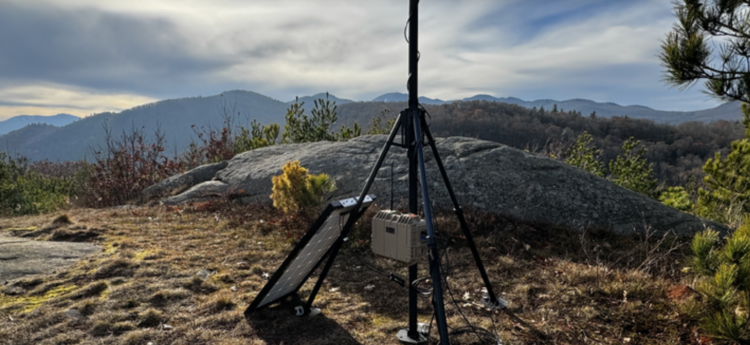
Recently, goTenna introduced its new EdgeRelay device. This specialized infrastructure support node provides continuous coverage for two separate goTenna mesh networks. It is designed for durability in harsh environments and offers solar power and other external charging capabilities to prolong mission endurance. This enables the extension of the goTenna mobile mesh network, providing essential communications and situational awareness capabilities—through the use of the TAK Application or goTenna Pro application—in the planet’s most austere and off-grid locations.
Click “Play” on the video below to get more information about the EdgeRelay from goTenna’s Luke Stewart:
The EdgeRelay offers a range of versatile mounting options, eliminating the need for costly and complicated installations. Whether for tactical deployments on buildings or permanent installation on mountaintop towers, the EdgeRelay provides a cost-effective solution for mission operators to blanket an operational area with hundreds of square miles of mesh network connectivity per relay.
Thanks to the EdgeRelay’s rugged, survivable, and flexible nature, it is purpose-built to enable mission-critical communications either well in advance as semi-permanent infrastructure or adapt to temporary emplacements as the mission requires.
Let’s look at three network deployment scenarios that leverage the EdgeRelay and some potential mobile mesh use cases.
Use case: Mobile mesh network coverage expansion for emergency response
Many missions and operations require coverage over a large geographic area. Some are temporary—such as wildland fire scenarios—and others are permanent—such as establishing a mobile mesh network for a border region or an entire national park or wildlife refuge; in these instances, EdgeRelays can be deployed at strategic high-elevation points within the region to extend coverage over hundreds of square miles – even linking relays to cover thousands of square miles.
Without EdgeRelays on the network, teams or individuals operating within the same vicinity could communicate via mesh using goTenna Pro X2 devices. These devices would connect via Bluetooth or cable tether to their primary mobile device, enabling communications and situational awareness capabilities within that region. However, each team would be operating in a somewhat isolated bubble and unable to connect to other users or teams outside their immediate area.
By adding EdgeRelays to strategic points of elevation between these disparate pockets of connectivity, operators could effectively connect everyone. This configuration would eliminate the individual bubbles of connectivity and enable a broader blanket of connectivity, enabling everyone to communicate. Each additional EdgeRelay added along the area of operations would extend the network further.
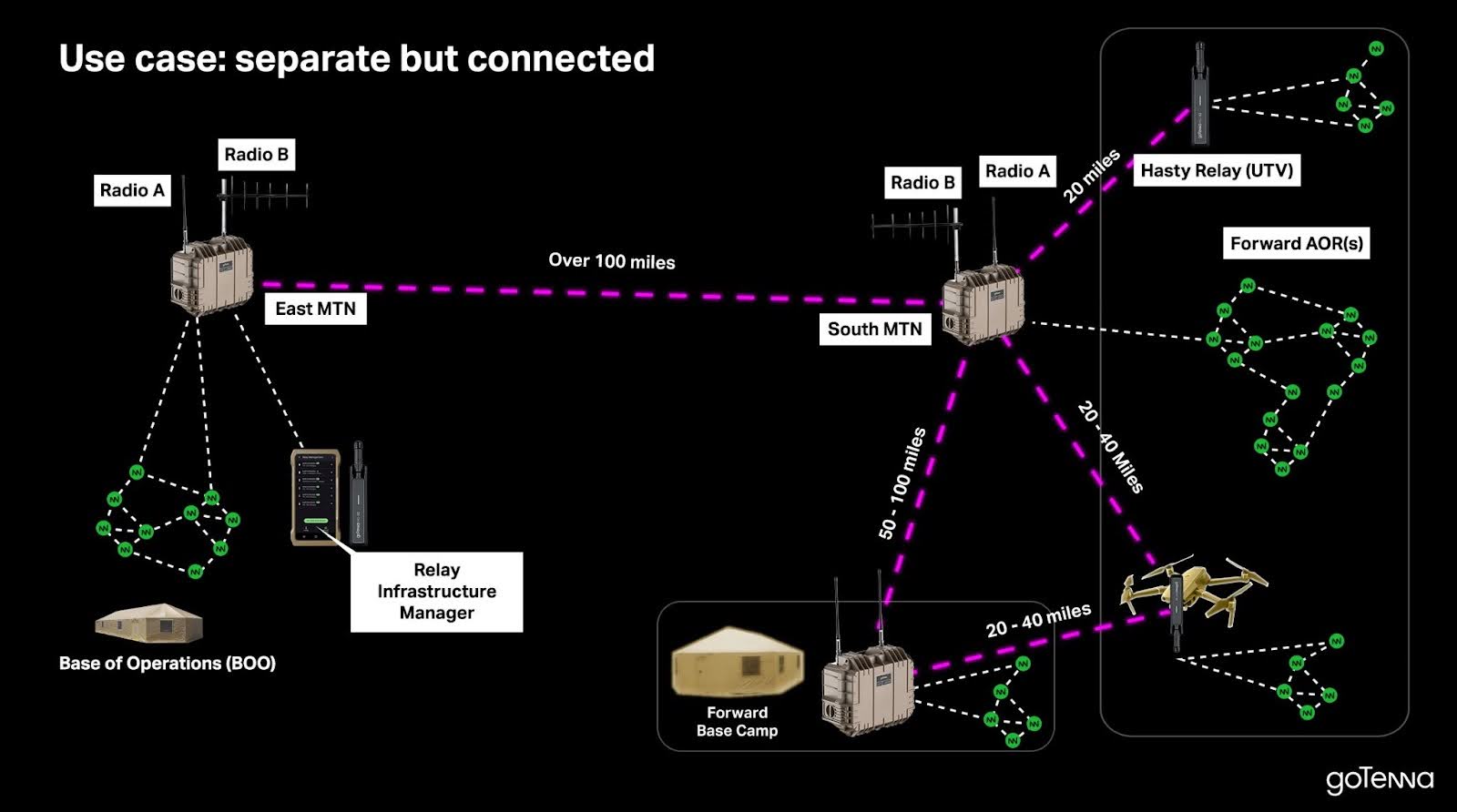
Let’s examine one of those proposed use cases to see how this could work in the field.
In wildland fire scenarios, multiple hotshot and firefighting crews could be operating in different areas, trying desperately to stop the spread of the fire, save lives, and reduce property damage. Depending on the size and scope of the fire, these crews could be operating in small pockets distributed across hundreds or even thousands of miles. For example, the largest fire in California history – August 2020’s August Complex Fire – burned more than 1,600 miles of terrain.
Strategically placed EdgeRelay devices could connect these distributed pockets of connectivity, enabling all individuals and crews to communicate beyond their localized bubble. Long-haul point-to-point connections between deployed EdgeRelays would allow forward-deployed responders to connect to other crews seamlessly. It would enable connectivity back to the base of operations for messaging, location, and continuous map object updates without having to move positions to establish comms (for example, up to a ridgetop). Any single responder could communicate with the entire operational team should they require assistance, need resources, or need to share information, leading to a more effective firefight.
WITH THIS MANY PEOPLE USING DATA-INTENSIVE APPLICATIONS, MOBILE NETWORKS IN THE AREA CAN OFTEN BECOME UNRELIABLE OR OVERBURDENED, MAKING THEM UNPREDICTABLE FOR PUBLIC SAFETY PERSONNEL ON THE SCENE…
The ability to rapidly deploy EdgeRelay devices would shine in a wildfire or other disaster response environment. It establishes communications almost immediately when operators arrive at the scene. EdgeRelays can also be removed and relocated quickly should the scenario change – generally by one or two people, depending on the deployment mode. This type of flexibility is essential because of the often unpredictable nature of fires, flood waters, and storms, which the EdgeRelay was specifically designed to address! No longer are logistics folks scrambling for a vehicle or tractor to move a comms trailer or portable tower out of harm’s way.
Ultimately, this configuration would be an excellent option for rapidly establishing mobile mesh network connectivity over a region experiencing—or recently experiencing—a natural disaster or other emergency event, whether pre-positioned or post-impact, EdgeRelays at strategic locations would keep everyone coordinated and connected while providing the flexibility and stability needed to keep communications active and available for the entire mission. Imagine communication throughout an active natural impact such as a hurricane, earthquake, or tornado without reliance on cellular network and power.
Use case: special event deployment
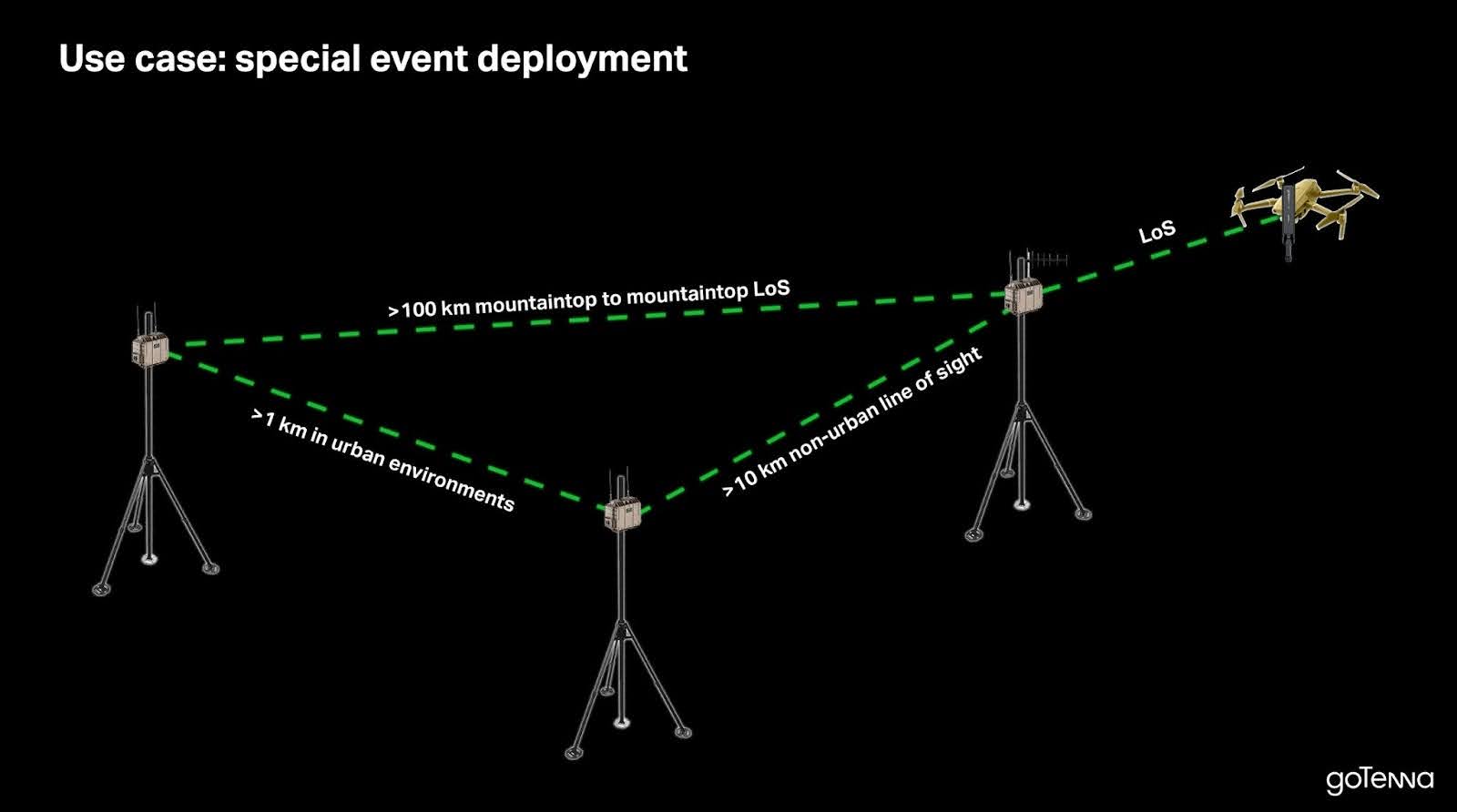
Large-scale public events often involve crowds of people in a small area, generally outside the mobile network operator’s capacity planning. In today’s world, there is a good chance these individuals will be sharing pictures, live streaming, video chatting, or using payment apps during the event via their mobile devices.
With this many people using data-intensive applications, mobile networks in the area can often become unreliable or overburdened, making them unpredictable for public safety personnel on the scene. This challenge means the agencies involved in keeping the public safe must have an alternative communications capability in the event of a disruption, such as a natural disaster—or worse—events falling prey to acts of violence.
Pre-positioning goTenna EdgeRelay devices around a particular event could be an excellent way to overcome this communications and situational awareness challenge. By establishing EdgeRelays at strategic points around the event’s perimeter, public safety personnel can effectively blanket the entire area with connectivity, building a network that will enable communication and situational awareness even when mobile networks are overburdened.
Let’s look at a timely example. Every year, major marathons are run along routes in major cities, bringing thousands of athletes and spectators to the area. Sadly, we also know the darker side of what these large gatherings can turn into. While organizers have undoubtedly meticulously planned for that outcome, real-time communications are needed throughout. This threat is why organizations should have a plan that ensures seamless situational awareness.
THANKFULLY, THE GOTENNA EDGERELAY CAN SUPPORT UP TO TWO SEPARATE MOBILE NETWORKS OPERATING IN THE SAME GEOGRAPHIC AREA…
For a successful event outcome, public safety teams require a common operating picture (COP). The event’s PACE (Primary, Alternate, Contingency, Emergency) communications plan should also ensure that the COP information can flow from responders on the ground to regional command to unified event command no matter what happens to communications networks. The information for situational awareness must flow up the chain of command regardless of what is happening. Many public safety organizations already employ TAK for electronic situational awareness to provide connectivity over multiple means – a capability where goTenna’s TAK plug-in is deployed with Pro X2 mobile mesh routinely.
In this use-case, EdgeRelays could be strung along the approximately 26-mile-long linear route of the marathon. The EdgeRelays could be connected in strategic locations, offering several miles of linear backbone connectivity per relay while easily providing dozens of square miles of lateral coverage around each relay location. Using standard antennas on the most modest elevation points such as hotel or office building rooftops along the route, the EdgeRelay’s internal battery and solar panel could keep the system running even without other external power options for the entire duration of the race, including staging days before and a day after the event – ensuring operation even if there is disruption to grid power or backup systems. As a friend of mine likes to say: “No Power, no Comms! No Comms, no COP!”
This configuration can also provide connectivity for an area without a special event. Take a military forward operating base (FOB) as an example. EdgeRelay devices can be positioned strategically around a FOB to blanket the entire base in connectivity in even the most austere and remote locations, providing situational awareness to those who are responsible for keeping the base secure.
Use case: separate but connected
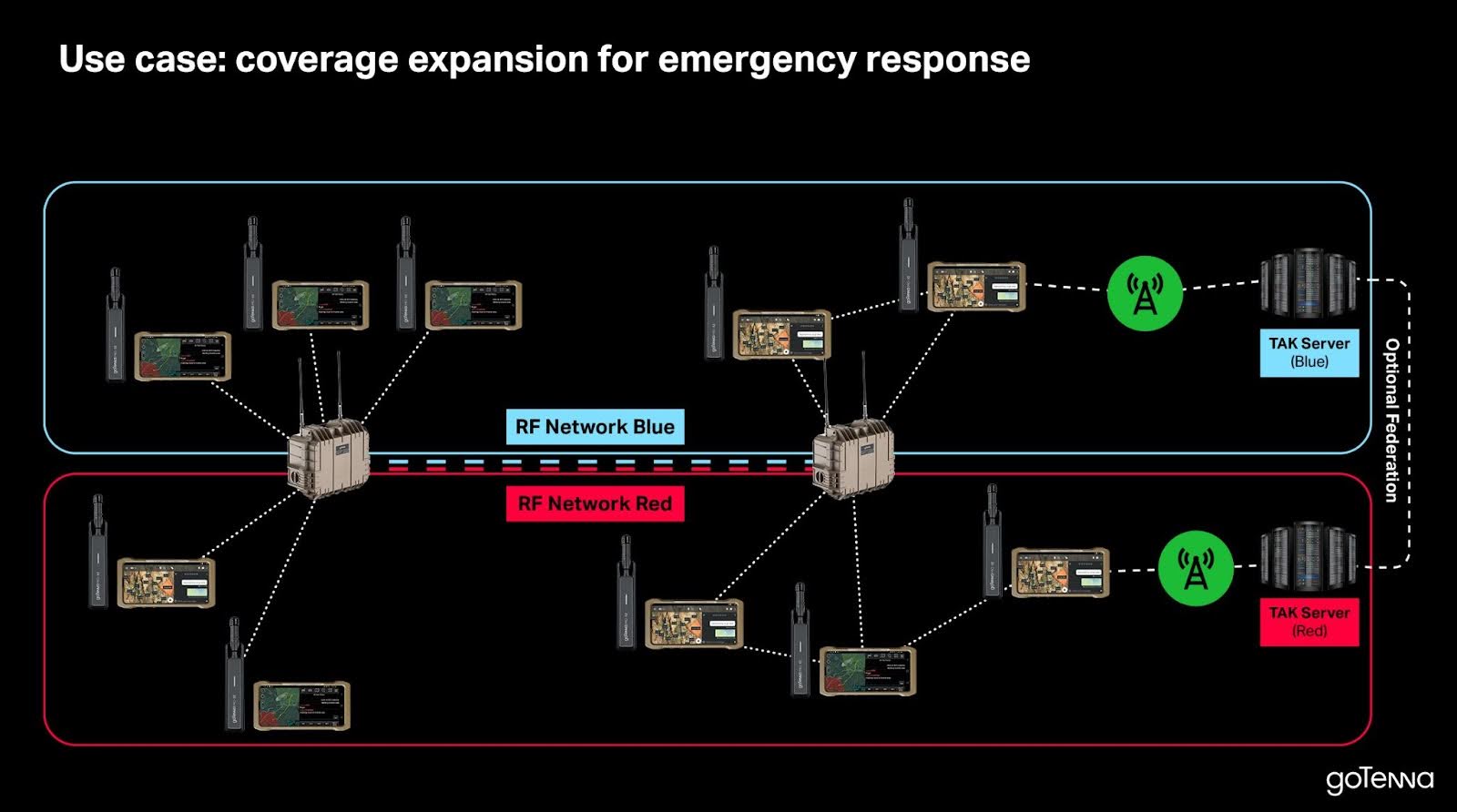
Many operations involve personnel from different organizations. Sometimes, they may even involve official military, law enforcement, or emergency response personnel working with private industry or volunteers. Everyone must stay connected in these instances, but some organizations may want to keep their information and communications from being broadcast to the entire group.
Thankfully, the goTenna EdgeRelay can support up to two separate mobile mesh networks operating in the same geographic area. This setup enables coverage and communications over a large geographic area while enabling disparate organizations to keep their data private.
For example, let’s say a Federal agency routinely conducts search and rescue operations in a remote and rugged area of federal lands. They’re often joined by local, state, and maybe even volunteer organizations. The area around which the search is required is incredibly austere, isolated, and dangerous. It also features large swaths of land with no terrestrial or cellular networks that operators can use to communicate. These areas are ideal for mobile mesh networks. (Recently, goTenna covered over 1,000 square miles in a mountainous, austere environment exercise.)
…IT CAN ENABLE MILITARY, LAW ENFORCEMENT, AND EMERGENCY RESPONSE ORGANIZATIONS TO DEPLOY ANY NUMBER OF MOBILE MESH NETWORKING CONFIGURATIONS IN EVEN THE MOST REMOTE, OFF-GRID LOCATIONS…
Knowing the areas without connectivity from terrestrial and cellular networks, the operations teams could deploy semi-permanent EdgeRelays on regional elevation points and keep them powered with solar panels. Placing EdgeRelays in cellular dead zones would ensure that connectivity is always available in these areas when needed. The agency could offer to share the connectivity of the second network (including different frequencies) with state, local, or tribal governments to use for operations that may not involve federal deployment. In this way, the infrastructure serves dual-use and is used by the local agencies for day-to-day operations. Should the agencies wish to share data, they could leverage federated TAK servers on the back end to provide inter-agency interoperability. This would allow each agency to operate within its operational agency boundaries yet be fully able to share information in a cooperative deployment.
The goTenna EdgeRelay is an exciting new addition to goTenna’s mobile mesh networking solutions catalog. It can enable military, law enforcement, and emergency response organizations to deploy any number of mobile mesh network configurations in even the most remote, off-grid locations. With the ability to operate on external power and many mounting options, these can be deployed rapidly or in advance to deliver the connectivity needed for practically any mission. These three use cases and configurations are just a few of almost unlimited possibilities.
To learn more about goTenna’s EdgeRelay solution, click HERE. For more information on how to monitor EdgeRelay networks remotely from one app, download our Relay Health Manager app 1-pager HERE.


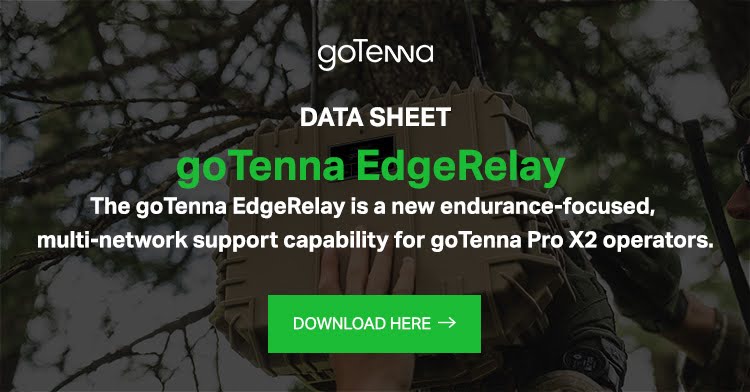


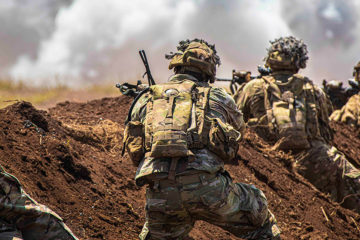


No Comment